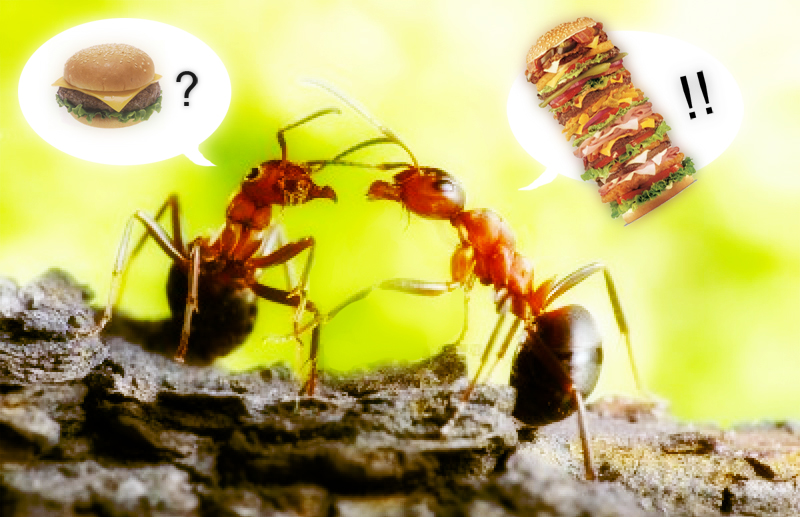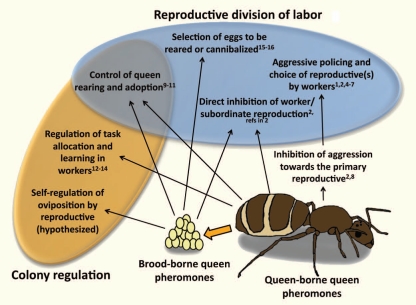Eusocial & Colony Behavior in Ants
Biology 342 Fall 2012
Celina Ortiz & Jason Swinderman
Mechanism
The lens of mechanism investigates the biochemical means by which organisms behave. This can encompass macroscopic physiology or microscopic chemical signaling, interactions, and synthesis. In a nutshell, mechanism describes how exactly animals do what they do. In this section, we will be exploring how ants communicate with each other.

Pheromones
The term pheromone is defined as a substance released by an organism to the outside that causes a specific behavioral or physiological reaction in a receiving organism of the same species. Ants use pheromones to communicate a variety of information to other ants, such as information about food or danger. These pheromones can be airborne (ex: pheromones from mandibular glands and abdomen of queen bees), or they can come directly from the body (ex: feeding on secretions given other insects). Pheromones and other forms of communication are vital to any colony social organization.
Below is a fascinating video that visually shows how ants leave pheromone trails when 1) looking for food, and 2) after finding the food.
Pheromone 3-MeC31 inhibits sexual maturity of worker ants to maintain eusocial sterility
Queen ants of the species Lasius niger were shown to use a pheromone 3-MeC31 (cuticular hydrocarbon 3-methylhentriacontane) to maintain worker infertility, an action known as behavioral sterility. The amount of 3-MeC31 is correlated to the fecundity and maturity of the queen. 3-MeC31 was found to inhibit ovarian production and reduce hostility in workers. Thus, 3-MeC31 is an honest signal from the queen, indicating her health and ability to reproduce that is used by the workers to assess colony health. Tentative results suggest that 3-MeC31 has various honest signaling roles in maintaining colony function and interactions between workers and the queen.
Diagram showing the role of 3-MeC31 pheromone in regulating behavioral sterility.
Antennal Contact
Ants usually use pheromone trails to recruit other ants for food-gathering tasks, but there are species of ants that do not, such as the harvester ant (Pogonomyrmex barbatus). This is because they scavenge for food a single ant can carry easily, such as a seed. These types of ants communicate food information through brief antennal contact. This information helps regulate ant foraging behavior. If not enough food is available, ants will communicate this through their antennas and scavenger ants will be sent out. As more food comes in, foraging behavior will decrease proportionally.

![]()
![]()
![]()
![]()
![]()
![]()
![]()
![]()
![]()
![]()
![]()
![]()
![]()
![]()
![]()
![]()
![]()
![]()
![]()
![]()
![]()
![]()
![]()
![]()
![]()
